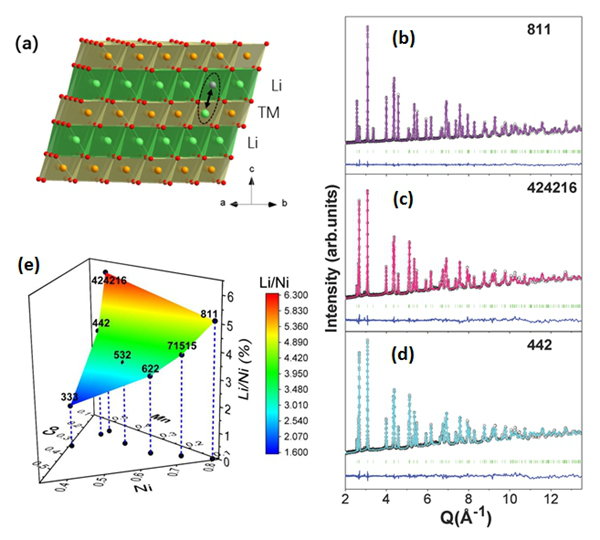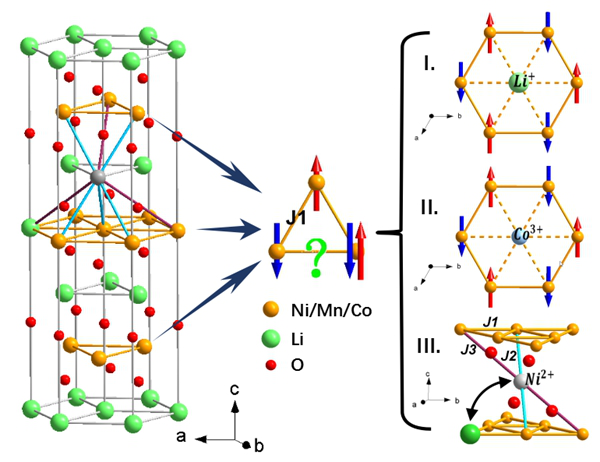Scientists have made a big step forward in studying the structural characteristics and mechanism of the formation of Li/Ni exchange in the lithium-ion battery cathode materials LiNixMnyCozO2, through high resolution neutron powder diffraction experiments at the National Institute of Standards and Technology (NIST), USA, and the China Spallation Neutron Source (CSNS). Published in Nano Energy, a well-known materials science journal, on April 17th 2018, these are the first scientific results generated at CSNS.
The researchers found that LiNixMnyCozO2 materials are a strong magnetically frustrated system, and the Li/Ni exchange can act as an effective way to relieve the frustration in LiNixMnyCozO2.This provides a unique viewpoint to study the Li/Ni ion exchange in layered Li(NixMnyCoz)O2 cathode materials.
Lithium-ion batteries are widely used because of their light weight, high specific energy and long service life, and the layered transition metal oxides LiNixMnyCozO2 are considered a very promising candidate for cathode materials in lithium-ion batteries. However, Li/Ni exchange usually happens in these materials, because of antisite defects in which a Li ion resides on a Ni site and vice versa. Generally, it is nontrivial to precisely probe the Li/Ni exchange by using common experimental approaches such as X-ray powder diffraction and scanning transmission electron microscopes.
By taking advantage of the high sensitivity of neutrons to the nuclei of lithium and transition metal atoms, scientists have made joint efforts to conduct neutron powder diffraction experiments, using the time-of-flight General Purpose Powder Diffractometer (GPPD) at CSNS, as well as the high resolution powder diffractometer BT1 at NIST in the United States.
The results of a systematic study showed that the Li/Ni exchange ratios in series of LiNixMnyCozO2 materials have been precisely determined for the first time. This not only helps further clarify the relationship between defect structure and performance in such battery materials, but also has a direct application in developing cathode materials for lithium-ion batteries.
The research was led by Prof. Pan Feng and Prof. Xiao Yinguo from the School of Advanced Materials at Peking University Shenzhen Graduate School, Prof. Qingzhen Huang from the NIST Center for Neutron Research (NCNR), and the GPPD group headed by Dr. He Lunhua from the China Spallation Neutron Source (CSNS).
CSNS, located in Dongguan, Guangdong Province, is the first pulsed spallation neutron source in China. In March 2018, the CSNS passed its technology acceptance test, which means the project construction is complete. Part of the neutron diffraction experiments were conducted using one of the 3 initial instruments, the GPPD at CSNS, resulting in the first scientific research article of CSNS. This work was financially supported by the National Materials Genome Project, the National Natural Science Foundation of China, Shenzhen Science and Technology Research Grant, and the CAS Youth Innovation Promotion Association.
 (a)Schematic drawing of the layered crystal structure of LiNixMnyCozO2compounds.(b-d) Neutron powder diffraction refinement patterns. (e)Li/Ni exchange ratios of Li1-xNixMnyCozO2compounds with different compositions of transition metals
(a)Schematic drawing of the layered crystal structure of LiNixMnyCozO2compounds.(b-d) Neutron powder diffraction refinement patterns. (e)Li/Ni exchange ratios of Li1-xNixMnyCozO2compounds with different compositions of transition metals
 Illustration of a pair of Li/Ni exchange and arrangement of magnetic moments in the TM layer of triangular lattice. The local structure and exchange interactions are modified upon the Li/Ni exchange. Three different ways to relieve magnetic frustration are denoted as I, II, and III. The paths of exchange interactions are labeled as J1, J2 and J3.
Illustration of a pair of Li/Ni exchange and arrangement of magnetic moments in the TM layer of triangular lattice. The local structure and exchange interactions are modified upon the Li/Ni exchange. Three different ways to relieve magnetic frustration are denoted as I, II, and III. The paths of exchange interactions are labeled as J1, J2 and J3.



